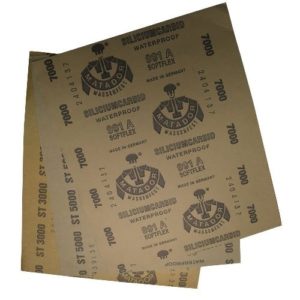
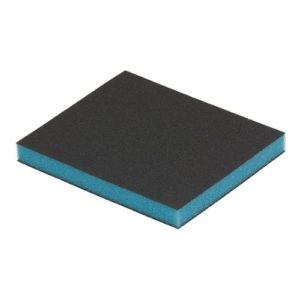
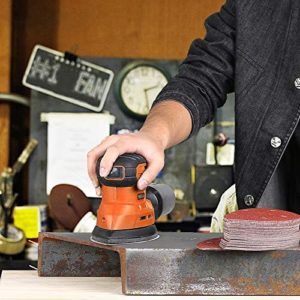
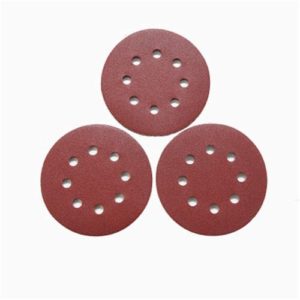
Sandpaper is a kind of paper that has been coated with sand or other abrasive materials. It is often used in leatherwork to smooth out the edges and the flesh side of the leather.
When sanding leather, an abrasive paper is applied to the surface (grain side) or reversed with a spinning roller (flesh side). Therefore, the surface is uniform. Such practice was performed entirely by hand in the early days of leather manufacturing.
Leather has to be cared for to serve a long time. During usage, the material can withstand abrasions and scratches. Before fixing scratches, streaks, color imperfections, and tears, use sandpaper to smooth off these flaws. This procedure gives your aged leather a flawless, like-new appearance.
If you need a reliable sandpaper sheet to work with your leather garment, check the following review of top 5 sandpaper sheets for manual leatherwork. The comparison table, reviews with pros and cons, buying guide can help to make a final decision.
SACOORA High Precision Polishing Sanding Sheets– the best for extra fine polishing!
 Check the premium flexible sandpaper sheets made in Germany. These are waterproof abrasive sheets with different grit sizes – from 3000 to 7000.
Check the premium flexible sandpaper sheets made in Germany. These are waterproof abrasive sheets with different grit sizes – from 3000 to 7000.
This medium-size sandpaper offers silky texture polishing for metal, plastic, natural leather, stone, lacquer, stone, etc. These are the finest sheets for polishing different leather accessories.
Pros
- Suitable for wet and dry polishing;
- Designed for extra fine polishing;
- Can cope with almost any material;
- Different grit sizes;
Cons
- Very thin;
- Won’t cope with rough leather;
- Expensive;
It’s a fantastic leather polishing product. It will not contain high spots or grits that are uneven.
COLOURLOCK Leather & Vinyl Sanding Pad– the best for extra fine polishing!
 This Colourlock sanding pad was specifically made for extra rough polishing of nubuck and suede pieces. Its coarse, double-sided texture is ideal for smoothing rough areas before applying leather dye to motorcycles, luggage, handbags, and other leather accessories and garments.
This Colourlock sanding pad was specifically made for extra rough polishing of nubuck and suede pieces. Its coarse, double-sided texture is ideal for smoothing rough areas before applying leather dye to motorcycles, luggage, handbags, and other leather accessories and garments.
It aids in the sanding down of light scratches on leather as well as the smoothing out of any rough areas for a clean, even finish.
Pros
- Provides a smooth surface even on the roughest areas;
- Cleans greasy spots on suede and nubuck;
- Double-sided sandpaper;
- Good for leather shoe polishing;
Cons
- Only 1 sheet;
- Too coarse for thin materials;
- May rip if you push too hard;
It’s a good idea to use it to smooth over rough spots before applying leather dye. This material will be applied to sand plastic trims and dashboards in addition to leather.
Coceca Mouse Detail Sander Sandpaper– the best for extra rough polishing!
 One of the best sandpaper sheets for extra rough polishing of natural leather objects. The package includes 120 pieces of sandpaper. There are 6 different grit sizes for every 20 pieces – from 40 to 240 sizes. The sheet size is a bit small but good for medium-size leather garments.
One of the best sandpaper sheets for extra rough polishing of natural leather objects. The package includes 120 pieces of sandpaper. There are 6 different grit sizes for every 20 pieces – from 40 to 240 sizes. The sheet size is a bit small but good for medium-size leather garments.
The sandpaper is made of high-quality alumina abrasive and is antistatic, making it suitable for polishing and sanding.
Metal and non-metal, iron, rubber, plastic, leather, stone, glass, and other materials can be polished with the help of this item.
Pros
- 6 different grit sizes for extra rough polishing;
- Easy to use;
- Durable;
- Practical;
- Made of aluminum oxide abrasive;
- Hook and loop technique;
Cons
- Won’t fit some sander devices;
- Average quality;
Furniture, decor pieces, and craft pieces will all benefit from the use of these Coceca sanding sheets. To get a clean and smooth surface before adding paints and dyes to furniture and art projects, use this method.
FRIMOONY Store Sanding Discs – the best for the grit size!
 Check the ultimate Frimoony Store package of 60 sanding discs of 6 different grit grades. The grit sizes range from 240 to 1000. These discs fit any sander with 8 holes (5 inches). The sheets are made of durable abrasive – aluminum oxide. It is also anti-static.
Check the ultimate Frimoony Store package of 60 sanding discs of 6 different grit grades. The grit sizes range from 240 to 1000. These discs fit any sander with 8 holes (5 inches). The sheets are made of durable abrasive – aluminum oxide. It is also anti-static.
The manufacturer recommends using it for leathercraft, woodworking, plastic, artificial stone, glass.
These discs are very durable, and the price is unbeatable.
Pros
- Each sheet has a grit size mark;
- Suitable for most sanders;
- Good for fine and rough polishing;
- Versatile uses;
- Economical;
Cons
- Won’t cope with wood;
- Only for small and medium-sized objects;
This sandpaper is often used to grit and paint metal and non-metallic objects with a variety of diverse surface corrosion.
The Buyer’s Guide
Base layer/material
The major thing to think of is the sandpaper’s base coat. While it is often referred to as sandpaper, it is not necessarily made of paper. Sandpaper may have a cloth foundation or a mixture of paper and cloth as its base layer, in addition to the standard paper base.
1) The paper only base
Paper-based sandpaper is not just common, but it is also the cheapest.
This kind of sandpaper foundation is disposable due to the fact that the paper is not the most robust substance. Paper-based sandpaper is likely to be discarded with just one application.
2) The fabric base
The sandpaper with a cloth/fabric foundation, on the other side, is even more durable.
This is because the fabric-based sandpaper is covered with specific resins that make it moisture-repellent properties.
As a result, the fabric-based sandpaper may be washed and reused. This style of sandpaper is unique in that it can be used to sand hard-to-reach areas on your leather.
3) The combined paper and fabric base
Sandpaper with a mixed base layer of paper and cloth is the final form of sandpaper base.
If you want to create a very sturdy sandpaper piece that you can apply to thin your leathers over and over again, this is the sandpaper type to use.
Your sandpaper blocks would be moisture and wear prone, and you will be willing to re-use them.
Grit size
Grit is a unit of measurement for sandpaper abrasiveness. It’s also used to gauge the size of the sandpaper’s abrasive compounds.
In general, the higher the grit rating, the finer the abrasion and the smoother the sanding on the leather surface.
Similarly, the lower the grit level, the coarser the sandpaper’s abrasion. Lower-grit sandpaper can normally sand leather quicker:
- Extra coarse/rough sandpaper with a grit of 24 to 36 is rough. It’s for scraping stubborn paint and varnish that you don’t believe would fall off. Sanding old leather furniture can often necessitate the use of extra coarse/rough sandpaper due to its abrasiveness. Don’t really consider doing this for all but the most difficult jobs;
- Coarse sandpaper. The rugged shaping of wood and the lack of prior finishes, such as light coats of polyurethane, are the strengths of coarse sandpaper. The 40- to 50-grit range is common for coarse grits;
- Medium sandpaper. Any final shaping may be done with medium sandpaper that ranges from 60 to 100 grit. Medium-grit sandpaper is also the safest choice for rough wood sanding and the removal of preparation markings on wood;
- Fine sandpapers are available in grits ranging from 120 to 220-grit range. This sandpaper would suffice for final sanding until the job is done in most home workshops;
- Extra-fine sandpaper. Between coats of varnish and paint covering the leather object, extra-fine sandpaper is frequently used. Quite fine grits are 240, 320, and 400, whereas extra- or superfine sheets of grits up to 600 are better for polishing than other sandpaper products;
How to use sandpaper for leather?
- Wet a 600-grit sandpaper piece and sand the whole surface of the leather item in small circles;
- Sand down the little bits of leather that may get elevated during wear, smoothing over scratches and other distressed places;
- Because of the abrasiveness of the sanding, the pigment dye will better penetrate the leather;
Leather-Toolkits is a great source of all leathercraft related reviews and news. One of my readers asked to recommend the best sandpaper for making leather goods smoother and softer. The recommendation grew into a full-fledged review with the guidelines for choosing and buying the sandpaper sheets for people who create DIY accessories of raw animal skin.
How to select sandpaper sheets for leathercraft?
The sandpaper is a specific material that is a must-have for any leathercraft workshops. It is used to grind irregularities and roughness of the surface to give it a perfect, smooth polish and eliminate greasy spots on a raw animal skin.
This material differs by its gritting size and thickness of the basic layer – whether it is made of paper of fabric:
- The paper base is the most common and cheapest option. It is easy to tear into pieces of different sizes. It has fine grits that are perfect for final sanding. However, this option can be considered a disposable and single-time material: rip off a piece, use and then throw away;
- The fabric base is a much more wear-resistant material. Most often it is layered with special resins to provide the moisture-repellent properties. After one use, it can be washed with water, dried and then used again. It is good for smoothing hard-to-reach places;
- There is also a combined basic layer (paper + fabric) – this is the most durable sandpaper type. Thanks to the fabric, it has an elastic and water-repellent property;
As for the gritting size, sandpaper has such parameters:
- P40 – P60. It is used in woodworking. Such materials should be used if there are some knots or chips on the wooden surface. I wouldn’t recommend picking it for thin and smooth leather;
- P70 – P120. The main work is aimed at surface cleaning. Removal of old lacquer or paint coat. It is also good for leather polish.
- P150 – P180. It is awesome for the final surface treatment before decorating, applying a primer or paint;
- P220 – P360. It’s ideal for intermediate sanding phases. For example, when you need the interlayer sanding before applying any lacquer;
Top 3 Best Sandpapers for Leather Goods: Opinion of Leather-Toolkits
Taking into account all the above-mentioned recs, I’d like to specify the top 3 best sandpapers for leather:
- Bonoho offers a premium waterproof German paper in a package of 6 pieces;
- COLOURLOCK is a good pick if you want to smooth the rough edges or the areas with too much grease. Also, this paper is made in Germany;
- The Cacys-Store items are brand new at the market. Their products can boast exceptional quality.
Also, I came across the Chicprime sandpaper and was quite surprised with its awesome polishing effect, low cost and great durability. As you can see, even my review has already got updates because new great sandpaper type keep appearing in the market of leathercraft tools and accessories. I’d like to know your opinion on this matter, so please, write about your experience with sandpaper for leather in the comments. Thank you for reading this blog!
Useful Video: Sanding Leather Using Sandpaper
Final thoughts
Keep in mind that only high-quality sandpaper sheets can provide fine polishing results for your leather accessories, clothes, furniture and garments. Make sure to check the user reviews, grit size and benefits of each product before buying.




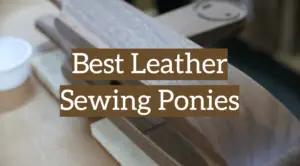





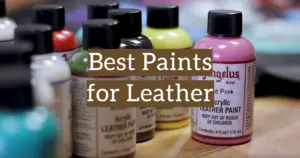





Your blog is so interesting – I’ve learned a lot! I’m interested in leatherworking but I’m still a complete beginner. I didn’t even know there was a special kind of sandpaper for leather.
Hello, Marc! Thanks for the comment.
To make your leather look excellent… a great idea is to use leather sandpaper. It adds a great deal of rusticness to the leather and also cleans it at the same time. I highly suggest using this to amp up the look of old leather.